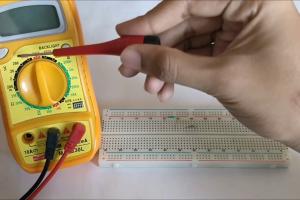Mastering Resistance Measurement: A Comprehensive Guide to Using Multimeters

-
Quick Links:
- Introduction
- What is a Multimeter?
- Types of Multimeters
- Understanding Resistance
- How to Measure Resistance with a Digital Multimeter
- How to Measure Resistance with an Analog Multimeter
- Common Mistakes to Avoid
- Expert Tips for Accurate Measurements
- Case Studies: Real-World Applications
- FAQs
Introduction
Measuring resistance is a fundamental skill in the world of electronics. Whether you are a hobbyist, a student, or a professional technician, knowing how to effectively measure resistance with a multimeter can save you time and money. In this comprehensive guide, we will explore both digital and analog multimeters, provide step-by-step instructions for measuring resistance, and share expert insights to enhance your understanding.
What is a Multimeter?
A multimeter is a versatile instrument used to measure voltage, current, and resistance in electrical circuits. It can be found in two main types: digital and analog. Digital multimeters (DMMs) provide a numerical display of measurements, while analog multimeters use a moving needle to indicate readings on a scale.
Types of Multimeters
- Digital Multimeters (DMM): These offer precise readings, typically with a variety of features including auto-ranging, data logging, and backlighting.
- Analog Multimeters: These have a needle and scale and are often preferred for their simplicity and reliability in certain applications.
Understanding Resistance
Resistance, measured in ohms (Ω), is a measure of how much a material opposes the flow of electric current. Understanding resistance is crucial for diagnosing electrical problems and ensuring circuit functionality. This section will cover the basic principles of resistance, including Ohm's Law, which states that voltage (V) = current (I) x resistance (R).
How to Measure Resistance with a Digital Multimeter
Measuring resistance with a digital multimeter is straightforward. Follow these steps:
- Turn Off Power: Ensure the circuit is powered off to avoid damage to the multimeter.
- Set the Multimeter: Turn the dial to the resistance (Ω) setting. If your multimeter has multiple ranges, select the appropriate range.
- Connect the Probes: Insert the black probe into the COM port and the red probe into the VΩmA port.
- Touch the Probes to the Component: Place the probes on either side of the resistor or component you wish to measure.
- Read the Display: Wait for the reading to stabilize, and then record the resistance value displayed on the screen.
How to Measure Resistance with an Analog Multimeter
Measuring resistance with an analog multimeter requires a slightly different approach:
- Power Off the Circuit: As with the digital multimeter, ensure the circuit is de-energized.
- Set the Multimeter: Turn the dial to the resistance setting.
- Connect the Probes: Attach the black probe to the COM port and the red probe to the Ω port.
- Place the Probes: Touch the probes to the resistor or component.
- Read the Needle Position: Observe where the needle points on the scale to determine the resistance value.
Common Mistakes to Avoid
- Measuring resistance on a powered circuit.
- Using incorrect probe connections.
- Not allowing the reading to stabilize before recording.
- Reading the wrong scale on an analog multimeter.
Expert Tips for Accurate Measurements
- Always zero your multimeter before taking measurements.
- Use the appropriate range setting for more accurate readings.
- Keep your probes clean and in good condition.
- Consider temperature effects on resistance for precision measurements.
Case Studies: Real-World Applications
To illustrate the importance of resistance measurement, we will explore a couple of case studies:
- Case Study 1: A technician troubleshooting a malfunctioning appliance found a burnt resistor using a multimeter, verifying the need for replacement.
- Case Study 2: An engineering student measured the resistance in various materials to understand their conductive properties for a project.
FAQs
1. What is the difference between resistance and impedance?
Resistance is the opposition to direct current, while impedance includes both resistance and reactance, which affects alternating current.
2. Can I measure resistance in a powered circuit?
No, measuring resistance in a powered circuit can damage the multimeter and give inaccurate readings.
3. How do I know if my multimeter is functioning correctly?
Test it on a known resistor to verify the accuracy of the readings.
4. What should I do if I get a reading of “OL” on my digital multimeter?
“OL” indicates over-limit, meaning the resistance is higher than the selected range; switch to a higher range.
5. Are analog multimeters still useful today?
Yes, they are particularly valued for their reliability and the ability to see trends in readings.
6. What is the importance of measuring resistance?
Measuring resistance helps in troubleshooting circuits and ensuring components function correctly.
7. Can I measure resistance in a diode?
Yes, but ensure the diode is removed from the circuit for accurate readings.
8. How often should I calibrate my multimeter?
Calibration should be done annually or whenever a significant drop in accuracy is observed.
9. What units is resistance measured in?
Resistance is measured in ohms (Ω).
10. What precautions should I take when using a multimeter?
Always ensure the circuit is powered off, use the correct settings, and handle probes carefully to avoid short circuits.
Random Reads
- Safely remove water charging port
- Save emails from outlook
- How to make flint and steel in minecraft
- Mastering ping in linux
- Mastering picture tiling microsoft word
- How to lay a brick patio
- How to launch a rocket in kerbal space program
- How to invite someone on skype
- How to play poker
- How to play sims 3 without cd